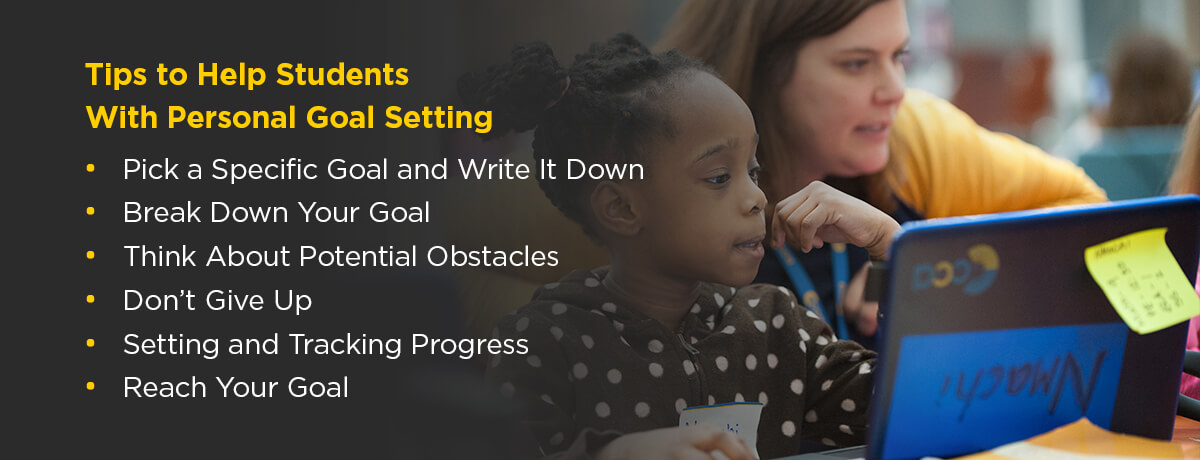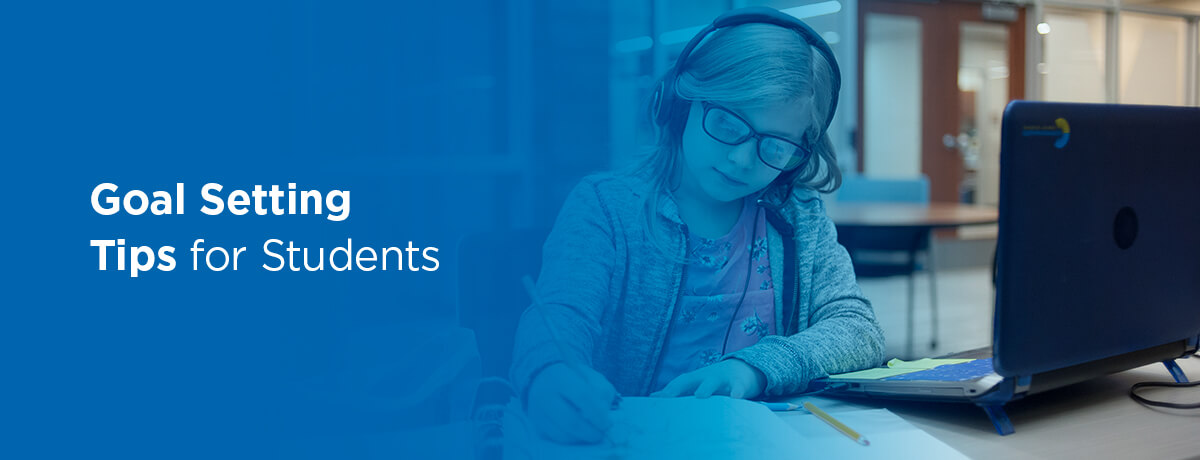A goal is more than a dream. A goal is a desire set in motion and made real through action steps.
Childhood is the time to instill lifelong habits of goal setting and tracking that breed success. Personal goal setting for students helps children build good study habits. Student goal setting provides direction and clarity, helping children understand the satisfaction and opportunities that come from academic achievement. Goals can be motivators, encouraging children to overcome barriers.
Children can pursue short-term goals, such as passing that test next week, or long-term goals, such as attending a prestigious summer program or making the varsity team. These tips help parents and their children work together on setting and achieving realistic goals that lead to accomplishment.
The Importance of Setting Academic Goals
Setting academic goals instills good habits and new behaviors in students beginning at a young age. Goals can help sharpen focus, reduce procrastination and create momentum. They promote a sense of control over your own life, helping you measure and manage the parts of life that could use improvement. It’s important for students to start setting academic goals because doing so strengthens important life skills like work ethic. Goals can motivate students while they’re in school and prepare them for college and a future career.
Academic goals help with student motivation, providing a straightforward path to success. With a clear focus, students will feel more confident in their work. Setting goals also helps teach students time management skills. Learning how to set goals at a young age will help children in school and help them with planning for their futures. Being able to set goals in college and in the workplace will help them excel and succeed.
Doing so shows a work ethic and desire to better themselves and the work they’re producing — a desirable quality both in the classroom and when looking for prospective jobs.
Setting goals brings a desired future day into the present, making it real enough to strive for. Goals motivate children to put more effort into their pursuits, on the way to making that envisioned future day a reality. When a goal is accomplished, the satisfaction encourages children to continue doing even better, for a continuous circle of self-improvement. An effective goal is clearly stated and presents a challenge to stretch the mind.
What Is a SMART Goal?
Maybe you’ve heard about SMART goal setting for students. SMART goals have distinctive elements that, when put together, make the goal achievable.
Believe it or not, SMART goals date back decades. They have endured in business settings because they propel companies forward. If you’re wondering about how to teach goal setting to students, you’ll find that SMART goals are as useful for school as they are for business. SMART goal setting for students stands for:
- Specific: Goals should be specific so there is a clear focus. Students should try to answer who, what, why, and where questions when setting specific goals. For example, instead of saying they want to “get better grades,” their goal should be to “go to math tutoring after school three days a week.” This goal gives the student something specific to focus on.
- Measurable: Measurable goals allow students to track their progress, asking “how much,” “how many,” and “how will you know you accomplished the goal?” So, if a student is trying to improve their grade, they should have a specific grade they’re striving for. For example, “I want to improve my math grade from a B- to an A-.”
- Attainable: Students should set goals they can achieve. Goals should push your capabilities yet still be reachable and realistic. Reaching too far can be discouraging, so students should set attainable goals. For example, improving a math grade may not be attainable within a week. However, improving a math grade by the end of the quarter may be more realistic.
- Relevant: Because we’re responsible for putting in the work to achieve goals, students should set goals they actually benefit from. Relevant goals are worthwhile and can be completed during the current time. For example, improving a student’s math grade might not be the most relevant goal if their grades in other areas are worse than math.
- Timely: A time frame gives your child a date to aim for to complete the goal. Setting deadlines for goals gives your child something to work towards, instead of the goal being never-ending or not having enough time to complete it. For example, instead of improving a grade “by the end of the year,” students should aim for a specific date so it feels more tangible.
SMART goals provide an outline for effective goals for students. Defining objectives and a completion date can provide the necessary motivation and focus to push them to reach their goals.

Tips to Help Students With Personal Goal Setting
Goal setting takes time on the front end, but it saves time by establishing an organized approach to the school year. In turn, goal setting enhances student performance. Goal setting applies to high school students, as well as those in elementary and middle school.
Try these tips to make goal setting a habit in your household.
1. Pick a Specific Goal and Write It Down
Make your goal as specific as possible. Goals that are too broad become impossible to achieve because they can’t be broken into individual, achievable steps. Your goal should include what you want to accomplish, how you plan to accomplish it and when you want to accomplish it.
Long-term goals, such as “going to college,” can be overly broad. Instead, chunk them into multiple short-term goals, such as focusing on grades one semester at a time and participating in service projects. At CCA, college and career planning courses help learners develop and reach their goals. Personalized learning prepares children for jobs they love and the opportunity to give back to society.
2. Break Down Your Goal
Once your child has developed a specific goal, break it into smaller, more manageable steps. Think of the main goal as a ladder and each smaller goal as a rung. With each small goal accomplished, your child is closer to the top of the ladder. Every test that earns a good grade is one rung closer to all A’s and B’s on that report card.
3. Think About Potential Obstacles
Things don’t always go as planned. It’s impossible to predict every challenge ahead, but it’s possible to think of the likely ones. Brainstorm with your child any obstacles that might pop up. What can your child do to overcome those challenges? If one of those obstacles appears, your child will know how to handle it and it won’t become a barrier on the way to the main goal.
4. Don’t Give Up
Help your child understand that reaching goals can be hard. There might be rough patches, but that’s no reason to give up. At the beginning of the process, write the goals down and put them in a central, visible spot — in the bedroom, on the fridge door, or on a whiteboard in the learning space — to serve as a reminder. Make sure your child knows that, if he or she is struggling, it’s OK to ask for help.
5. Set and Track Progress
Helping your student write goals creates a living document that must be checked and revised constantly.
- Use examples: For younger children, start with shared reading of a book about goal setting and the difference between wishes and goals, such as “Froggy Rides a Bike.”
- Create a template for writing down goals and tracking progress: This might be an Excel spreadsheet, a Word table, or a worksheet. Create rows for each goal and action step. Create columns where you mark daily and weekly progress. Or draw a “goal ladder,” putting an action step and timeline on each rung.
- Find an app: Look for a goal-setting app that is easy to use, keeps accurate records and is customizable. Prices vary, so make sure your choice fits the family budget.
- Mark a calendar: While the nitty-gritty details can go on a document or app, put big-picture goals on a wall calendar and mark steps accomplished with stars and stickers. That makes your child’s goals a family affair, always open for discussion.
6. Reach Your Goal
When your child reaches a goal, it’s time to celebrate! Enjoy family dinner at a favorite restaurant, post the accomplishment on social media or plan a getaway.
Following these steps will help your child set, work toward, and eventually achieve cherished goals. It might not be easy, but it will always be worthwhile. Motivational goal-setting prepares your child for success, one school year after the other.
Student Goal Setting in Action
All children have different goals, depending on their interests, capabilities, and ages. Consider these examples.
Elementary School Goal
If a student sets their goal as, “I will get better grades in math,” they may take the following action steps:
- Study 30 minutes three days a week.
- Practice with flashcards twice a week.
- Help add up the grocery bill once a week.
- Explain a math problem to my little sister twice a week.
- Ask the teacher for extra help.
- Let my parents know when a test is coming up, so they can make sure I get enough sleep and exercise.
Middle School Goal
With a goal like “I will get an A in Honors Science,” a student might take the following action steps:
- Study science 60 minutes a day three times a week.
- Join the school science club.
- Attend two science-related field trips this semester.
- Ask the teacher for extra-credit assignments.
- Volunteer at a local science museum.
High School Goal
After setting the goal, “I will develop leadership skills to show on a college application,” a high school might take the following action steps:
- Serve as an officer for one school club.
- Perform volunteer service at the local food bank twice a month.
- Join a mission trip once this year.
- Run for school office.
- Tutor younger students.
Empowering Students With Personal Goal Setting
Teachers know that the benefits of goal setting make students better learners. The more they accomplish, the more they want to continue to succeed. Goals create a target to strive toward, as children build on each new competency learned. Goals teach children the importance of establishing priorities that help them sort out where to spend their time and energy.
At CCA, our students are continuously reaching their goals with the help of parent-teacher support systems and our flexible school system. For example, CCA student Molly Frack was able to achieve her goal of becoming a collegiate gymnast because of her hard work and flexible school schedule. Another CCA graduate, Zamir Deon Williams, accomplished his goal of publishing the novel he’d written during his junior year. His CCA teachers were abundantly supportive of his goal, helping him host two book signings.
Teachers and staff at CCA are dedicated to empowering our students, regardless of where they’re at with their personal or academic goals. Check out more success stories to find out how our students are achieving their goals.
Contact Us to Learn More
Commonwealth Charter Academy’s personalized approach to learning fuels a desire to learn and achieve by tapping into each child’s unique learning style and interests. With the recent release of Personalized Adaptive Learning (PAL) cards, CCA continues to make it easy for students to focus on academic goals.Learn more about CCA’s efforts to help students achieve personal academic goals. If you have any questions, feel free to visit our frequently asked questions tab to see what other parents and faculty are talking about.







